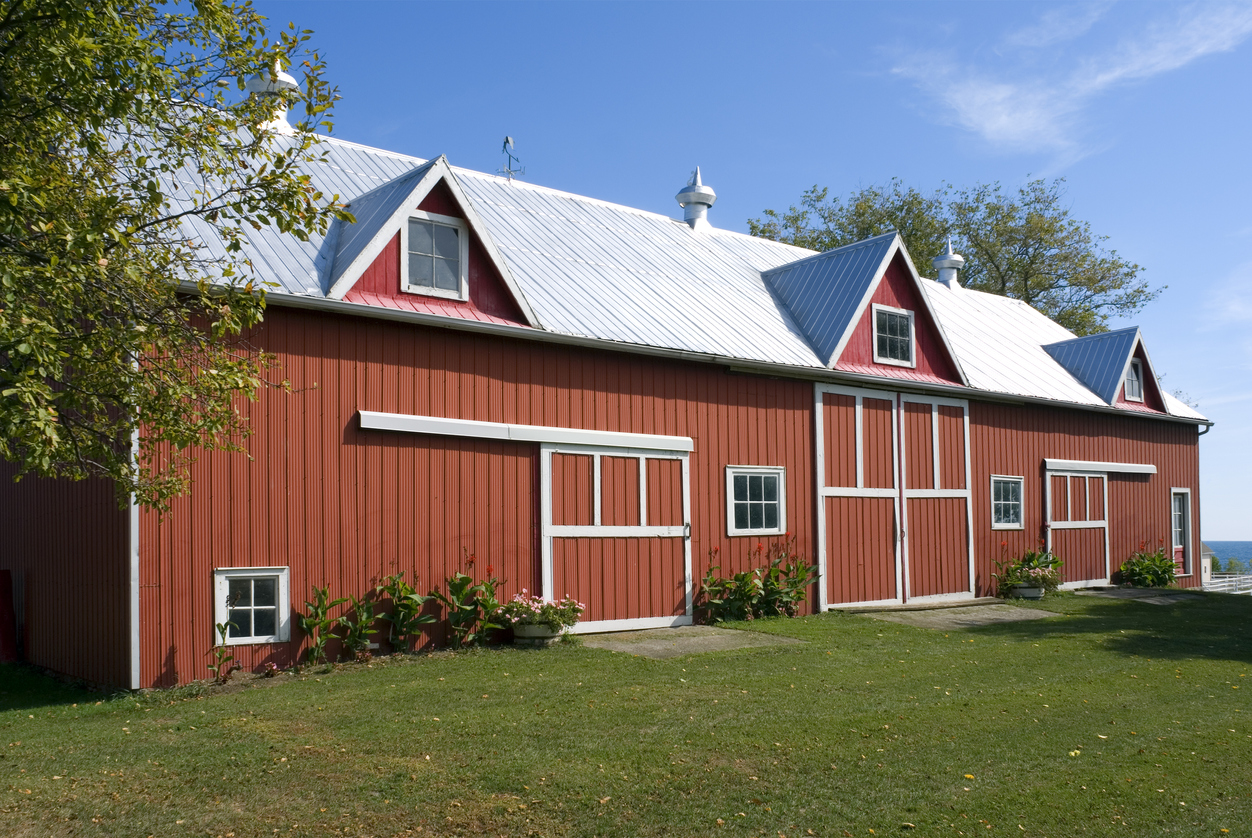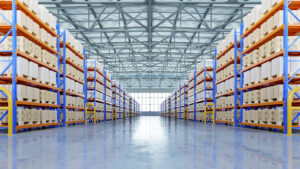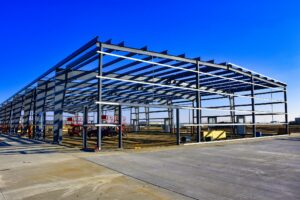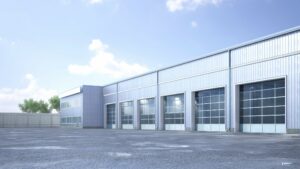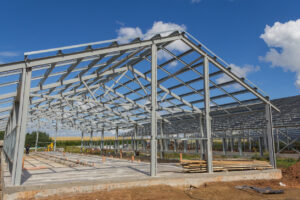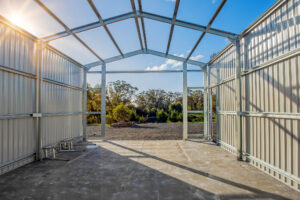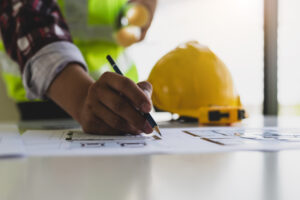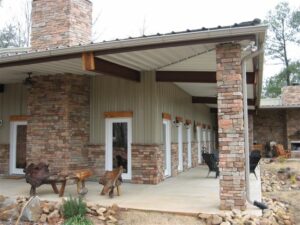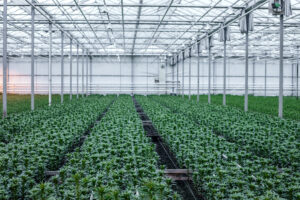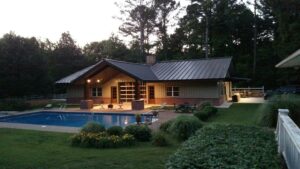Metal school buildings have become increasingly popular in recent years due to their numerous advantages over traditional construction methods. The maintenance cost-effectiveness of metal school buildings also make them an attractive option.
Anotehr significant trend driving the use of metal for building projects is the increasing preference for sustainable and eco-friendly materials. According to the 2023 report from the US Green Building Council, sustainability ranked the highest for most surveyed Engineering & Construction firms, as it is in line with their organizational mission and business strategies.
With the growing use of efficient building materials and sustainable construction practices, the industry is expected to be better positioned to drive changes and align with the International Energy Agency’s Net Zero Emissions by 2050 Scenario. This scenario requires all new buildings and 20% of existing structures to be zero-carbon-ready by 2030.
Understanding the basics of these buildings is essential for anyone considering this option for their educational facility.
In this article, we will discuss what metal school buildings are, their key features, benefits, construction process, maintenance, and future trends.
Table of Content
- Understanding the Basics of Metal School Buildings
- Benefits of Metal School Buildings
- Construction Process of Metal School Buildings
- Maintenance and Care for Metal School Buildings
- Future Trends in Metal School Buildings
- Conclusion
- Frequently Asked Questions
Understanding the Basics of Metal School Buildings
When we talk about Steel school buildings, we are referring to educational facilities constructed primarily using steel or metal components.
These buildings are designed and engineered to provide a safe, durable, and cost-effective learning environment for students.
What are Metal School Buildings?
These are structures that utilize steel or metal as the primary material for construction. These buildings often feature a steel frame and sheet metal panels for walls and roofs.
The use of metal offers exceptional strength, durability, and flexibility in designing school facilities.
Key Features of Metal School Buildings
They possess several key features that make them an attractive choice for educational institutions:
- Durability: Metal buildings are engineered to withstand harsh weather conditions, such as high winds, heavy snow loads, and seismic events, ensuring the safety of students and staff.
- Cost-Effectiveness: They are often more affordable than traditional construction methods. The use of prefabricated components reduces construction time and labor costs, making it a cost-effective solution for educational facilities.
- Environmental Impact: Metal buildings offer sustainable options, with opportunities for energy efficiency and the use of recycled materials in construction. This aligns with the growing emphasis on green building practices.
Furthermore, these buildings provide excellent flexibility in terms of design and layout. With steel as the primary material, architects and designers have the freedom to create innovative and modern learning spaces.
The strength of steel allows for larger open spaces without the need for excessive support columns, providing a more spacious and adaptable environment for students and teachers.
In addition to their structural advantages, steel school buildings also offer enhanced safety features. Steel is a noncombustible material, which means it does not contribute to the spread of fire.
This is particularly important in educational settings where the safety of students is of utmost concern. Metal buildings also can withstand extreme weather events, such as hurricanes or earthquakes, providing a secure shelter for students and staff.
Moreover, steel school buildings can be easily expanded or modified in the future. As educational institutions grow and evolve, the need for additional space may arise.
With metal construction, it is relatively simple to add new wings or sections to the existing building, allowing schools to adapt to changing needs without major disruptions to daily operations.
Benefits of Metal School Buildings
Metal school buildings provide several benefits that contribute to their increasing popularity:
Durability and Longevity
One of the significant advantages of metal school buildings is their exceptional durability and longevity. Steel structures are resistant to common issues such as rot, pests, and fire, ensuring the safety and longevity of the facility.
Moreover, Steel school buildings are designed to withstand extreme weather conditions, such as hurricanes, earthquakes, and heavy snow loads. This resilience ensures that students and faculty are protected in any situation, providing a secure learning environment for all.
Cost-Effectiveness
Metal school buildings offer significant cost savings compared to traditional construction methods. The ability to prefabricate components reduces construction time and labor costs.
Additionally, metal buildings require minimal maintenance, reducing long-term expenses for schools.
Furthermore, the versatility of metal construction allows for future expansions and modifications with ease. Schools can adapt to changing needs without the hassle of extensive renovations, saving both time and money in the long run.
Environmental Impact
As environmental concerns continue to grow, metal school buildings provide a sustainable solution. They can be designed to incorporate energy-efficient features such as insulation, solar panels, and rainwater collection systems.
Moreover, metals used in construction often contain a high percentage of recycled materials, reducing their impact on the environment.
Additionally, steel school buildings are known for their energy efficiency, helping schools reduce their carbon footprint and operating costs. By utilizing natural light and ventilation, these buildings create a comfortable and eco-friendly learning environment for students and staff alike.

Construction Process of Metal School Buildings
The construction process of metal school buildings involves several stages:
Designing the Structure
Before construction begins, the structure of the metal school building is designed using computer-aided design (CAD) software. The design includes considerations for aesthetics, functionality, safety regulations, and the specific needs of the educational facility.
The designing phase is a crucial step in ensuring that the metal school building meets the requirements of an educational institution.
Architects and engineers work closely together to create a blueprint that not only reflects the school’s vision but also adheres to local building codes and regulations.
This stage involves detailed planning of the layout, materials, and structural integrity of the building to guarantee a safe and efficient learning environment for students and staff.
Building and Assembly
Once the design is finalized, the components of the metal school building are manufactured off-site, allowing for precise construction without weather-related delays.
These prefabricated components are transported to the construction site and assembled by a skilled team of professionals following the design specifications.
Efficiency and precision are key factors during the building and assembly phases of metal school construction. The use of prefabricated components not only speeds up the construction process but also ensures consistency in quality and design.
Skilled workers follow a carefully orchestrated plan to erect the building, taking into account factors such as structural integrity, energy efficiency, and future maintenance needs for schools. This meticulous approach results in a durable and sustainable metal school building that can withstand the test of time.
Check out: Advantages Of Prefabricated Metal Buildings & Potential Drawbacks
Maintenance and Care for Metal School Buildings
Maintaining metal school buildings is crucial to ensure their longevity and continued functionality. Metal structures are known for their durability and strength, but proper maintenance is key to preserving these qualities over time.
By following a comprehensive maintenance plan, school administrators can protect their investment and provide a safe and comfortable environment for students and staff.
Regular Inspection and Cleaning
Regular inspections should be conducted to identify and address any maintenance issues promptly. This includes inspecting the roof, walls, windows, and doors for damage or wear.
Additionally, periodic cleaning helps remove dirt and debris, preserving the building’s appearance and preventing potential damage.
Inspections should not only focus on the exterior of the building but also include checks for any signs of water damage, corrosion, or pest infestations that can compromise the structural integrity of the metal building.
Dealing with Wear and Tear
Over time, metal school buildings may experience wear and tear. It is important to address any issues promptly to prevent further damage. This can involve repairing damaged panels, replacing worn-out components, and addressing any structural concerns.
Working with experienced professionals is essential to ensure that repairs are carried out correctly. In addition to addressing visible damage, it is important to consider preventive measures such as applying protective coatings to metal surfaces to prevent corrosion and extend the lifespan of the building.
Pro tip:
Steel buildings support clearspan construction, a distinctive feature that allows the creation of spaces over 350 feet wide without any column support. This is beneficial for school buildings as it provides uninterrupted space for gymnasiums, auditoriums, and cafeterias.
Future Trends in Metal School Buildings
The future of metal school buildings is bright, with advancements in technology and a focus on sustainability:
Technological Advancements
Advancements in technology are shaping the future of school buildings. This includes the use of advanced insulation materials, smart building systems, and integrated technology solutions that enhance the learning environment and promote energy efficiency.
One exciting technological advancement in metal school buildings is the incorporation of Building Information Modeling (BIM). BIM allows for the creation of detailed 3D models that help architects, engineers, and contractors visualize the entire building process, leading to more efficient construction and better coordination among project stakeholders.
Check out: Effective Strategies For Insulating Steel Buildings
Sustainability and Green Building Practices
The shift toward sustainability is influencing the construction industry, including school buildings. Future trends include improved energy efficiency, increased use of renewable energy sources, and the integration of sustainable practices into the design and construction process.
Another important aspect of sustainability in school buildings is the focus on indoor air quality. With the use of low-VOC (Volatile Organic Compounds) materials and efficient ventilation systems, these buildings can provide a healthy and productive environment for students and staff.

Conclusion
Metal school buildings offer a range of advantages, including durability, cost-effectiveness, and environmental sustainability. Understanding the basics, benefits, construction process, and maintenance requirements of school buildings is crucial for making informed decisions.
With advances in technology and the growing focus on sustainability, the future looks promising.
Since 2001, SteelCo has been a leading PEMB materials provider, dropshipping high-quality building materials across the US, and also offering commercial construction services in Georgia for a wide range of building and client industry types.
On the PEMB side, we assist our clients in navigating local building codes and construction timelines, providing basic conceptual designs and stamped engineering plans to simplify the process of obtaining necessary permits and licenses.
Learn more about our expertise in PEMB commercial buildings and how we can assist you in your metal school building project.
—————————
Frequently Asked Questions
How long does a metal building last?
Metal buildings can last several decades, with many steel structures enduring 50 years or more when properly maintained.
Which is better, steel or concrete building?
When deciding between steel and concrete for construction, it’s essential to consider the project’s specific needs. Steel buildings offer cost-effectiveness, faster construction, design flexibility, and sustainability due to their recyclability. They are also durable and low maintenance.
Concrete buildings, on the other hand, provide excellent strength, stability, superior fire resistance, and better thermal and sound insulation. The choice between the two materials should be based on factors such as budget, environmental conditions, and the intended use of the building, with each material offering distinct advantages for different scenarios.
How does the cost of metal school buildings compare to traditional construction?
While the initial material costs for metal buildings can sometimes be higher, the overall expenses are often reduced due to prefabrication and modular construction methods, which lead to lower labor costs and shorter construction times. School metal buildings require minimal maintenance over their lifespan, contributing to long-term cost savings. They are also known for their durability and longevity, which means less frequent replacements or repairs.
What are the typical warranties for steel school buildings?
Many manufacturers offer warranties that can last up to 20 years. These warranties typically cover important aspects such as the building’s roof and wall panels, providing peace of mind for the long-term durability and reliability of the construction.
What roofing options are available?
Pre-Engineered Metal Buildings (PEMBs) offer standard roofing options for diverse design preferences and functional needs. The gable roof is a classic choice with its dual sloping sides, while the hip roof presents a stable design with slopes on all sides.
The gambrel roof adds a traditional barn-like appearance with its distinctive slopes. For larger spaces, the clear span frame eliminates the need for internal columns, and the multi-span frame is cost-effective for wider buildings.
The single slope frame is practical for drainage considerations, and the lean-to frame is an economical extension solution. These options ensure that PEMB roofing is adaptable, durable, and suitable for a wide range of building projects.
How long does it take to construct a steel school building?
The construction timeline depends on various factors, such as the size, complexity, and location of the project. For medium to complex projects like metal school buildings, the project can be completed from quote to installation/construction in as little as 16-18 weeks.









